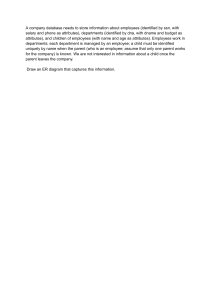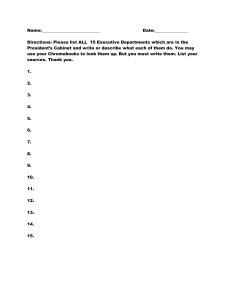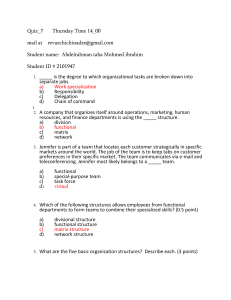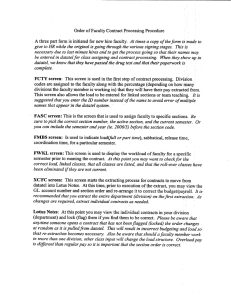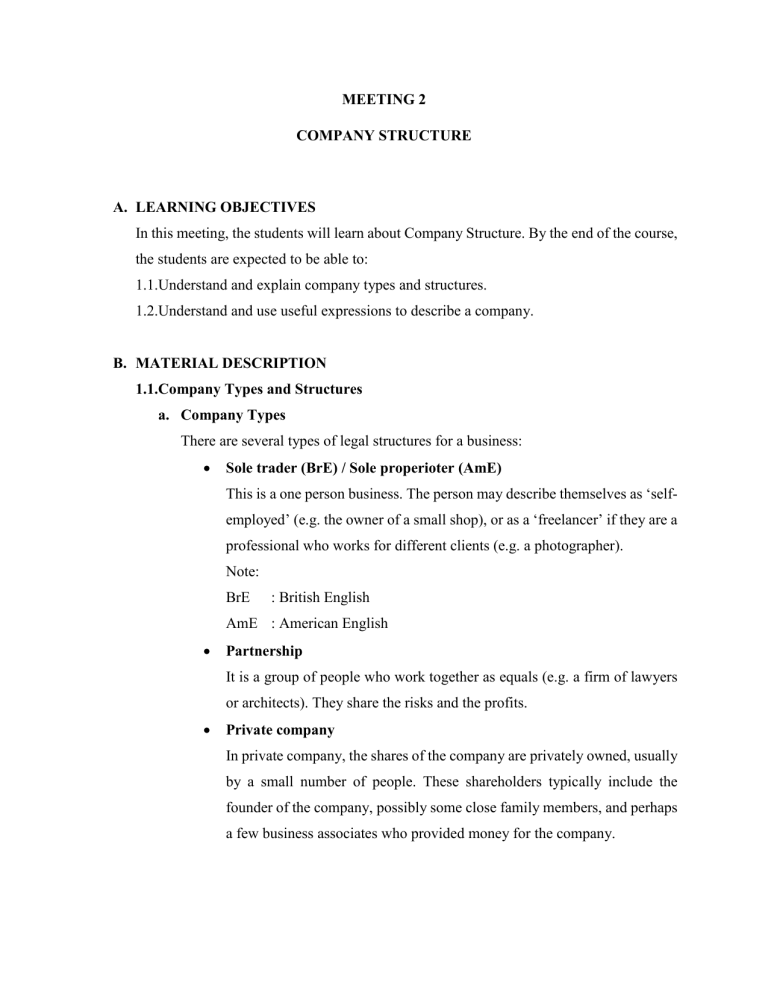
MEETING 2 COMPANY STRUCTURE A. LEARNING OBJECTIVES In this meeting, the students will learn about Company Structure. By the end of the course, the students are expected to be able to: 1.1.Understand and explain company types and structures. 1.2.Understand and use useful expressions to describe a company. B. MATERIAL DESCRIPTION 1.1.Company Types and Structures a. Company Types There are several types of legal structures for a business: Sole trader (BrE) / Sole properioter (AmE) This is a one person business. The person may describe themselves as ‘selfemployed’ (e.g. the owner of a small shop), or as a ‘freelancer’ if they are a professional who works for different clients (e.g. a photographer). Note: BrE : British English AmE : American English Partnership It is a group of people who work together as equals (e.g. a firm of lawyers or architects). They share the risks and the profits. Private company In private company, the shares of the company are privately owned, usually by a small number of people. These shareholders typically include the founder of the company, possibly some close family members, and perhaps a few business associates who provided money for the company. Public company (BrE) / Corporation (AmE) These are the large companies that are listed on stock exchanges like Germany’s DAX, France’s CAC or the UK’s FTSE. They are called public because anyone can buy their shares. b. Department The list of departments below is typical for many business – each one corresponds to a business function. Companies also have other departments related to their own particular business activity. Production might also include Purchasing and Quality Assurance (QA). Operations refers to all the internal processes of a company and might include, for example, Logistics. Sales might also include Business Development. Customer Services might include Technical Support. Marketing might include Market Research. Communications refers to all promotional activities including a strong focus on Public Relations (PR). Finance has many subdivisions, such as Financial Control, Treasury, Accounts and Payroll (managing salary payments). Human Resources (HR). Information Technology (IT). Research and Development (R&D). Legal. c. Organizational structures Some organizations, such as a high school volunteer club, exist to help people in need. Other organizations, such as a student council, exist to give students a voice at school. Business organizations exist to earn profits. To meet their goals, they organize their employees into some kind of structure. Companies adopt organizational structures in order to minimize confusion over job expectations. Having an organizational structure helps them coordinate activities by clearly identifying which individuals are responsible for which tasks. Companies generally adopt one of four organizational structures. These include: line structure, line and staff structure, matrix structure and team structure. Each of these different types of organizational structures can be shown in an organizational chart which is a visual representation of a business’s organizational structure. It shows who reports to whom within the company. It also shows what kind of work each department does. 1) Line structure In a line organization, authority originates at the top and moves downward in a line. All managers perform line functions, functions that contribute directly to company profits. Examples of line functions include production managers, sales representatives, and marketing managers. Line managers collect and analyze all of the information they need to carry out their responsibilities. Production managers, for example, hire and fire all of the assembly-line workers in their departments. They also order all of the supplies their department needs. Line organizations are common among small businesses. Larger companies usually require a different kind of organizational structure. 2) Line and staff structure In mid-sized and large companies, line managers cannot perform all of the activities they need to perform to run their departments. In these companies, other employees are hired to help line managers do their jobs. These employees perform staff functions. Staff functions advise and support line functions. Staff departments include the legal department, the human resources department, and the public relations department. These departments help the line departments do their jobs. They contribute only indirectly to corporate profits. Staff people are generally specialists in one field, and their authority is normally limited to making recommendations to line managers. 3) Matrix structure A matrix structure allows employees from different departments to come together temporarily to work on special project teams. The purpose of this kind of structure is to allow companies the flexibility to respond quickly to a customer need by creating a team of people who devote all of their time to a project. Once the team completes the project, the team members return to their departments or join a new project team. Companies that undertake very large projects often use the matrix structure. Boeing, for example, regularly assigns employees to project teams it creates to design new aircraft. Large high-tech firms also frequently use the matrix structure. 4) Team structure Many companies have abandoned the line and staff approach to organizational structure in favor of the team approach. A team structure brings together people with different skills in order to meet a particular objective. More and more companies are using the team structure. They believe this structure will allow them to meet customer needs more effectively than the traditional structure. The team structure is very different from the traditional organizational structure. In the traditional structure, each level of management reports to a higher management level. In this kind of organization, senior managers need not approve decisions by lower-level managers. Instead, teams have the authority to make their own decisions. Employees often prefer the team structure because of its focus on completing a project rather than performing a particular task. One company that has successfully used teams is IBM. Beginning in 1990 the company introduced self-directed management teams that it organized around customer needs. Each team tries to determine what the customer is looking for and develop strategies with which to meet those needs. The approach helps the company respond quickly in competitive markets. 1.2.Useful Expressions to Describe a Company a. Describing the activity of a department Examples: My department deals with marketing. My department is responsible for administration. We organize tests/studies/research. We work with customers/suppliers/subsidiaries/other companies in the group. b. Describing the staff of a department Examples: There are (20) people in the department. Pierre Ducros is in charge of the department. I am one of the managers/technicians/secretaries/engineers. c. Describing the equipment /premises of a department Examples: We have a large office/three laboratories/a small building. We use computers/fax/e-mail a lot. We have a well-equipped laboratory/a lot of technical equipment. Dialogue Example The structure of Biopaints International Presenter : Today we are talking to Philip Knight about the structure of Biopaints International. Philip is the General Manager of the Perth factory. Philip, do you think you could tell us something about the way Biopaints is actually organized? Philip : Yes, certainly. We employ about two thousand people in all in two different locations. Most people work here at tour headquarters plant. And this is where we have the administrative departments, of course. Presenter : Well, perhaps you could say something about the departmental structure? Philip : Yes, certainly. Well, now first of all, as you know we've got two factories, one here in Perth, Australia, and the other in Singapore. Lee Boon Eng is the other General Manager, over there in Singapore. Presenter : And you are completely independent of each other, is that right? Philip : Oh, yes. Our two plants are fairly independent. I mean, I am responsible to George Harris, the Production Manager, and we have to co-operate closely with Rosemary Broom, the Marketing Manager. Presenter : Mmm, yeah. Philip : But otherwise, as far as day to day running is concerned, we're pretty much left alone to get on with the job. Oh, and I forgot to mention finance. The Finance Director is Weimin Tan. She's a very important woman. And her task is to make sure the money side of things is OK. The accountant and such people, they report to her directly. Presenter : Is that all? Philip : Oh, no, no. There's Personnel too. Presenter : Oh, yes. Philip : That's quite separate. Deirdre Spencer is Personnel Manager. And the Training Manager reports to her, of course. Presenter : Are there any other features worth mentioning? Philip : There's the planning department—Brian Jones is in charge of that. And a purchasing department—they buy in the materials for production. C. EXERCISE 1.1.Exercise 1 Instructions: Answer the following questions correctly. 1. Why do businesses need organizational structures? 2. Why do some companies prefer to organize by teams? 3. In a business with a line and staff structure, why might conflict arise between line managers and staff managers? 1.2.Exercise 2 Instructions: This is case analysis. Read the situation and answer the question. Situation : You are the manager of a manufacturing company that employs 500 people. The owner of the company has given you free rein to reorganize the company however you want. Question : What type of organization would you recommend? a line, line and staff, matrix, or team structure? Give your reason! 1.3.Exercise 3 Instructions: Underline the correct word in italics. Example: My brother is a plumber. He’s autonomous / self-employed. 1. The people who own a private company might include the founder of the company, some family members, and perhaps a few business associates / companions. 2. In a public company anybody can buy the actions / shares. 3. A public company is listed / posted on a stock exchange. 4. Our railways were recently privatized. I think the service was better before, when they were a public company / state-owned enterprise. 5. The Purchasing Department is responsible for buying parts and raw materials / making the final product. 6. If you have a complaint, please contact Consumer Services / Customer Services. 7. All recruitment and selection is done by our Human Relations / Human Resources Department. 8. Innovation is the key to our success and we have recently expanded the Research and Design / Research and Development Department. 9. In the Legal Department we have three lawyers / advocates trained in commercial law. 10. It’s the CEO’s job to control / run the company. 11. I can’t take that decision. It will have to be referred to higher people / more senior people. 12. In the department there are six Sales Representatives and their line director / line manager. 13. She is part of / makes part of a team of designers. 14. The Sales Department has to liaise / liaison closely with Marketing. 15. I am the Financial Controller, and I relate directly / report directly to the Finance Director. 1.4.Exercise 4 Instructions: Complete the text about operations with the words and phrases in the table. back-office behind the scenes day-to-day basis liaise closely meet their needs recruit step on anyone’s functions makes a profit toes Everyone knows the functions of company departments such as Marketing and Finance. Marketing is about promoting the company, and making sure that customers can find products that 1...................................... . Finance is about controlling the resources of a company to make sure that the business 2 ...................................... . But what about Operations? The department name is less well-known, yet many large companies are run on a 3 ...................................... by Operations Managers. Operations is about the internal processes of a company. In a manufacturing company an Operations Manager will make sure the production process is running smoothly. In a hotel they are responsible for bookings, front desk, maintenance, etc. In a bank they look after the administration of accounts and other Operations Managers have to 5 4 ....................................... ...................................... with people from other departments. In the factory, it is with Purchasing Managers who buy the raw materials. In the hotel, it is with Human Resources Managers who 6 ...................................... new staff. In the bank it is with IT Managers who work 7 ...................................... to keep everything running. So the Operations Manager has to be careful not to 8...................................... . 1.5.Exercise 5 Instructions: Read the following passage and answer the questions that follow. Sysco Sysco makes over 4,500 products, developed specifically for customers - food retailers and foodservice providers. As such, Sysco makes and markets products for some of the largest restaurants and hotel chains in Canada. Sysco operates a decentralized divisional structure. The board establishes corporate strategy and the Group's business objectives. Divisional management integrates these objectives into divisional business strategies with supporting financial objectives. Managing Directors are responsible for the organic and new business development growth opportunities within their divisions. These divisions are composed of three to seven business units - grouped by a mixture of market, manufacturing skills or customer expertise. Each business unit is led by a General Manager, responsible for the achievement of business objectives and sustainable business performance. Each General Manager has a profit-responsible management team which concentrates on specific markets and customers. This devolved Group structure allows a close working relationship with our customers and one where day-to-day decisions can be made at business unit level, which is vital to the fast-moving nature of our business. Each Managing Director, together with functional heads, sits on the Sysco Management Board (operational executive team). Questions: 1. What are the Managing Directors responsible for? 2. How many business units are there in the divisions? 3. At which level are the day-to-day decisions made? 4. Who sits on the Sysco Management Board?
